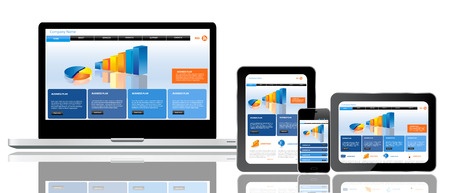Responsive web design is an imperative consideration to make when building your website. Why? Take a moment and consider all of the different devices you use to access the internet. Do you use a tablet to surf the web? Check email on your phone? Work from a desktop computer? Now think about all of the different ways your customers and clients access your website. More and more people are using mobile devices in place of oversized desktops.
According to recent studies and statistics:
More than 75% of all Americans who use the internet now access digital content on both desktop and mobile devices. Comscore
Mobile digital media time in the US is now significantly higher at 51% compared to desktop (42%). Smart Insights
According to Search Engine Watch, 99.5% of consumers use mobile devices to access information, 63.1% to access the internet, 62.1% to check email, and 15% to make purchases.
A staggering amount of people use mobile devices to access the web in addition to desktops and laptops, which is why responsive web design is extremely important in this day and age.
What is Responsive Design?
Responsive Web Design (RWD) is an assortment of techniques that designers use to create web pages that respond effectively by resizing themselves based on the type of device they are being used on. For example, the page would resize itself accordingly to fit a laptop screen, smartphone screen, or tablet screen. In addition to responding to size, responsive web design also takes into account which platform it is being used on and the orientation. Meaning if a person switched from a laptop to a tablet, the site would automatically adapt to changes in image size, scripting abilities, and resolution as well as layout to make it more user friendly. Simply put, a site utilizing responsive design automatically modifies itself based on whatever device is being used.
Multi-Device Users
It’s important to cater to and support multi-device users. People will be accessing your site from a variety of devices, and often times customers will visit your site on one device, say a desktop, and re-visit later on their tablet. You want your customers to have the same great experience with your site, and your company, regardless of the device they are using. This means that if they are able to access certain content from their laptop, they need to be able to see the same content from their phone. Consistency is key.
One Site Versus Multiple
One website can be a challenge to maintain, add in two or three more, and it becomes nearly impossible to keep everything up-to-date. Responsive websites are extremely helpful in these situations as you can use the same site across various devices. When you only have one site to manage it’s easier to keep up with maintenance and updates which ultimately results in a more satisfying experience for customers.
SEO
Google supports and recommends responsive web design. Sites that use responsive design to support a variety of devices now show up with a “Mobile Friendly” label when people are looking at search results on a mobile device. But there’s more. Because Google is such a big fan of responsive websites, they made the decision on April 21st, 2015 to reward mobile-friendly sites by raising them in search engine rankings.
Expand Your Reach
The more people that can access your website, the better. Making your site available across multiple devices not only expands your reach, it allows customers to return to your web page multiple times regardless of where they are or what device they are using. According to Business Insider, 11.3% of people in the US access the internet exclusively through a mobile device like a smartphone or tablet. If you aren’t utilizing responsive web design, you are potentially missing out on connecting with thousands of customers.

